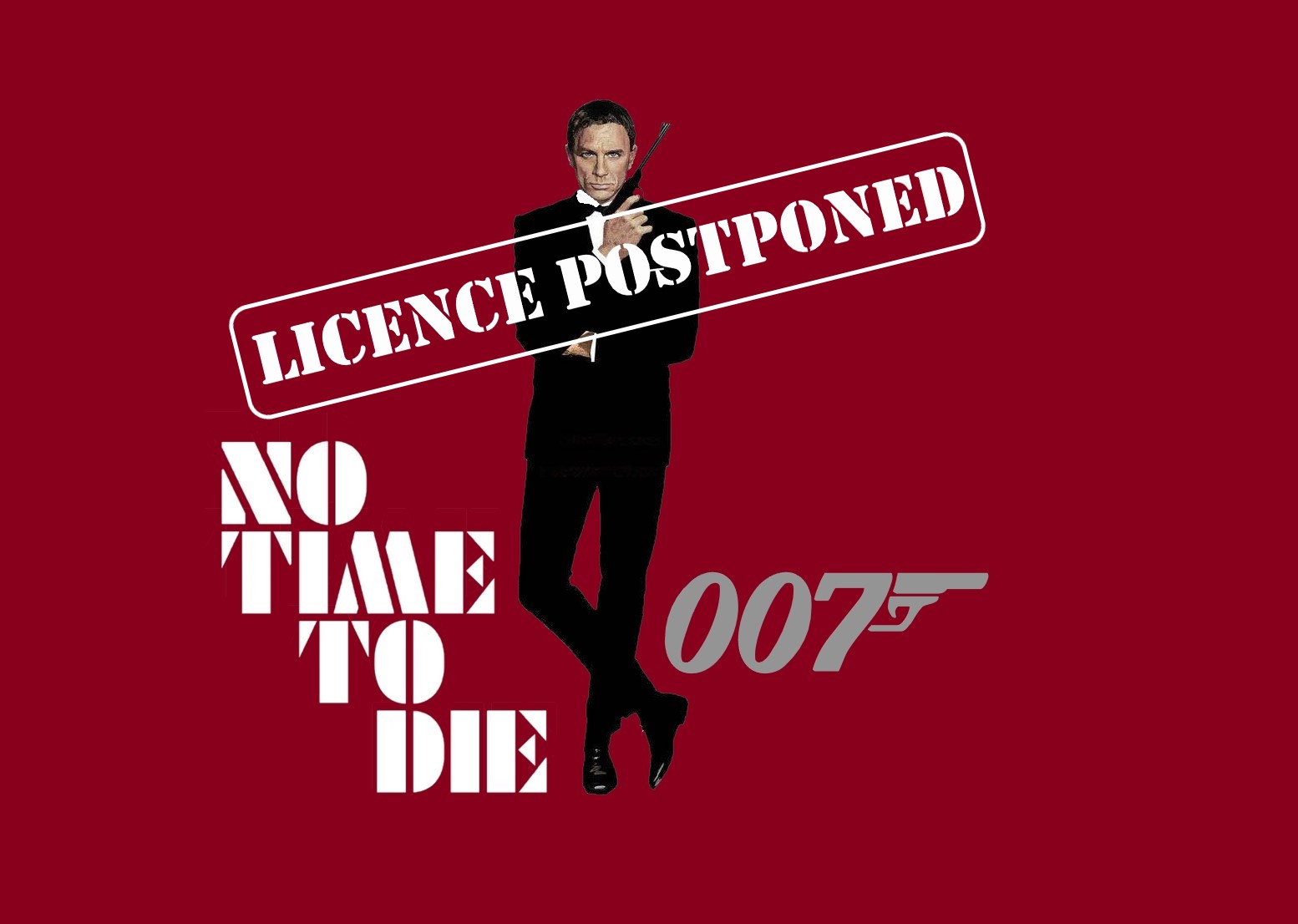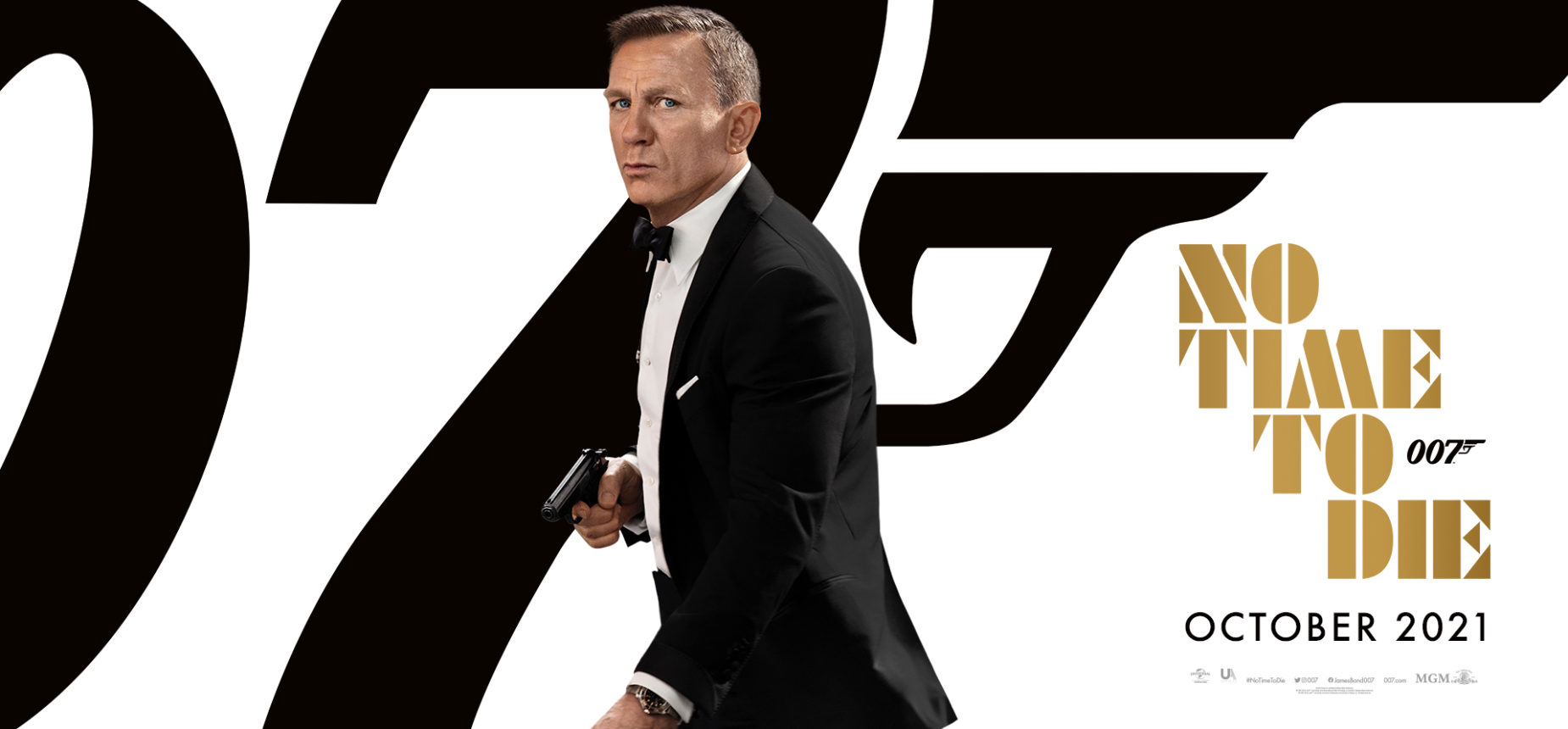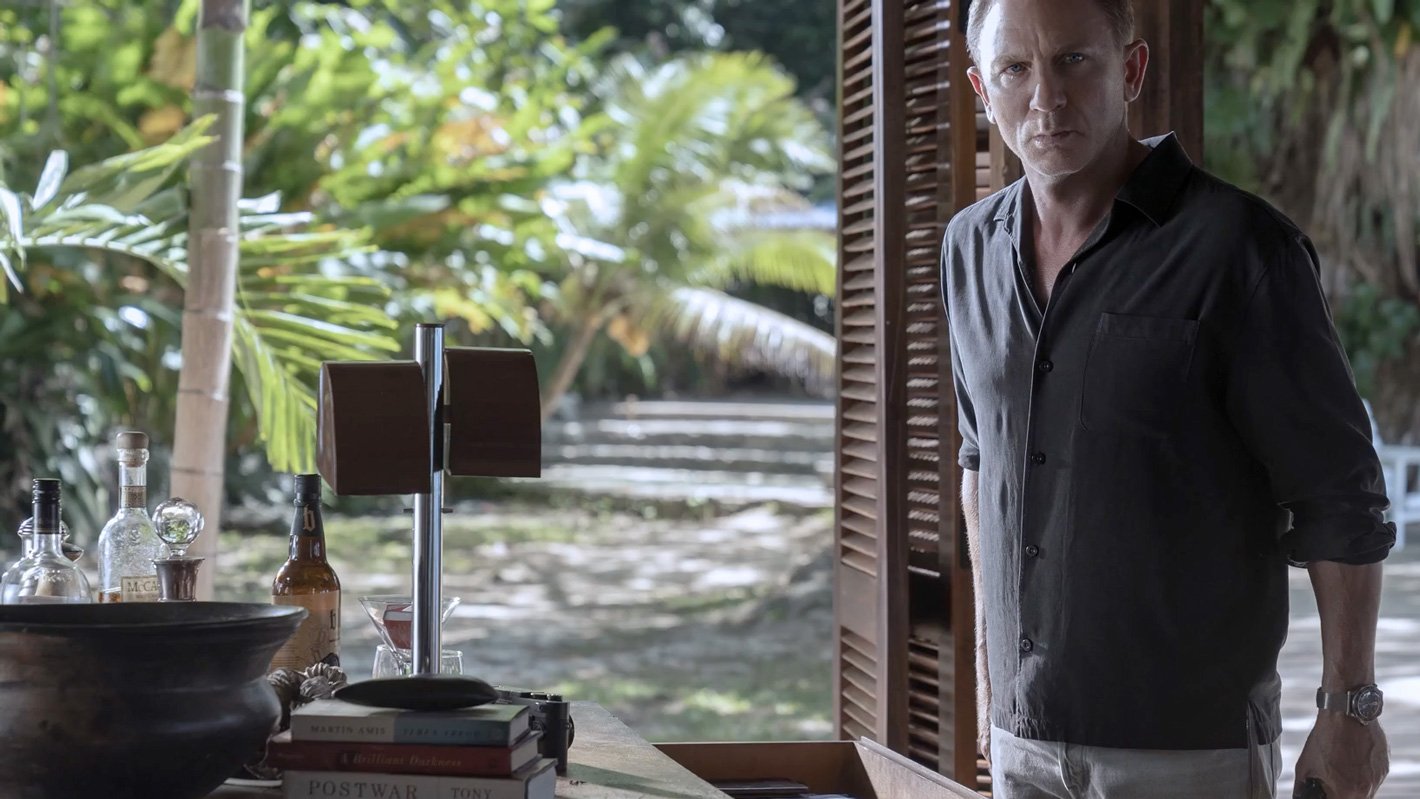
Art by Mark O’Connell / ‘Daniel Craig’ by Robert McGinnis

The third time is the charm. Maybe. For it looks like James Bond’s extended leave in Jamaica has been extended for a third time. In the world of high adventure the highest number is not actually 007 right now. It is Covid-19. And as the Coronavirus continues with a sense of some calm on some shores and is a definite tidal wave on others, the studio decision makers responsible for the twenty-fifth James Bond movie bullet No Time to Die have regrettably had to make to make a third sequel of sorts to the first delay announced in March 2020 – with a newly announced revised release date of October 2021.
‘Once is happenstance. Twice is coincidence. Three times is enemy action.’
Ian Fleming / Goldfinger / 1959
The postponement of the twenty-fifth Bond movie No Time to Die was sadly ever inevitable. This is not just Bond. This is every movie and studio’s hard decision, survival strategy and ultimately responsibility. Top Gun – Maverick, Ghostbusters – Afterlife, A Quiet Place – Part II, Dune, The King’s Man, The Eternals, The Many Saints of Newark, Black Widow, Candyman, Cruella, F9, West Side Story and Morbius have all had to also revise and delay their release plans. Add the global pandemic with many uncertainties and global companies like MGM, Universal and the Bond brand have to make hard choices. It is not a sign of weakness or brand fatigue. It is knowing how holding back is the long game that must be played. Bond is in the same Q-Boat as everyone else and every film navigating this virus. This is genuinely yet more tough news for a company of filmmakers who worked tirelessly to get a film ready and released as long planned and against a lot of controversy and media daggers. No one wants to fire this film at the world more than EON Productions. This was not a third decision made lightly. It is a definite current blow for movie fans. But, it is more of a blow for the movie industry and its multiple eco-systems.

When some lambast concerns for getting all our economies moving versus public health, they overlook how the economy – and yep, even the cinema industry – is about people’s health, safety and mental well-being. Safeguarding our health is also about safeguarding what inspires, entertains, distracts, comforts and employs us. And where. But the wider realities of why have to be remembered. A Bond film is a global event and a global adventure. It makes sane sense to remember ALL audiences across the world. Bond’s box-office is made up of many components – including China, Italy, France, Japan, South Korea, Germany, the UK and the USA. Just as your local multiplex might be mothballed, movie theatres at the other end of your county, country or continent might be less so. China curiously is currently experiencing great cinema attendance and movie houses are opening in New Zealand and Australia. The same happened in France and Spain in the summer of 2020, and parts of the UK throughout the summer and fall of 2020. People’s confidences may have changed, but blanket assumptions on the death of cinema are less productive. Or true.
‘You could just fiddle and tweak and it doesn’t necessarily get better. For all intents and purposes, we had finished the film. I had mentally finished the film. Mentally and emotionally.’
Director Cary Joji Fukunaga, Empire – August 2020
Unless we are to assume Bond is holding on until Billie Eilish is old enough to order a drink at the premiere after-party, we can look at the Vesper cocktail glass she might order as being either half empty or half full. No Time to Die was finished. Many titles, TV series, franchises and event movies were stalled during production and didn’t get to complete. Other great titles no one even realized were happening were lost altogether. Not one of Bond 25‘s over-reported delays stopped the film being made. Every production rescheduling – which happens on all big projects like a Bond – ensured the film was made. And this exhibition delay ensures the film is seen. And no – a VOD, streamed Bond film is not totally where the future of Bond will be, just yet – despite the studio partners MGM investigating the possibilities and reactions to floating a Bond upstream at a substantial cost no platform was appearing to pay. Whilst one reaction is ‘put it on Netflix‘ those calls fail to remember the future of Bond, the contracts and deals already inked in, the reality that not everyone has a Netflix subscription, and the small fact that No Time to Die also has to perform well (and differently to a Netflix Original) to gild the path for the next James Bond film, and the next James Bond. And did we mention piracy? How many of those that watched WW84 over Christmas 2020 were not actually HBO Max subscribers based in the US?
Streaming is still a newer window for cinema – an art form that has evolution and societal change at its very core. And whilst it is beneficial and emancipates many a film, VOD is one surrounded by myths. A big film like a Bond or WW84 does not have to jump onto home platforms to be kind to die-hard fans. That is not how tentpoles movies work. WW84 didn’t first stream over Christmas 2020 to leave festive gifts for DC fans. It streamed as a new streaming platform needed more subscribers and a multinational conglomerate holding company which held various cards played their hand.
Streaming could well one day be a mission option for Bond. It could even be part of this third release hope. However, suggesting beloved franchises just all float their new chapters up the virtual streams all has long-term ramifications. An all-streaming consumption will alter the scope, the reach, the size, the quality, the storytelling, the colour, and the very face of all cinema. Tentpole releases – which are always wholly fragile investments – would be less green lit. Smaller indie fare which needs the big boys and girls to exist would struggle. A lighting gaffer can afford to work for less on a Ken Loach film in the spring if he knows he has a Bond in the autumn. None of our movies come from a vending machine. None of our movies are as to challenging to make as they are to watch. They are the result of a vast network of industries, infrastructures and employments. Crews, technicians, studio staff, admin, make up, wardrobe, FX, caterers, unit managers, location wranglers, stunt teams, gaffers, sign writers, movement co-ordinators, assembly teams, screening room technicians, hair dressers, painters, seamstresses, IT teams, plasterers, carpenters, electricians, tutors, drivers, sound recordists, editors, graders, actors, writers, co-producers, police liaisons, medical teams, secretaries, wage teams, PR, insurers, accountants, fire guardians, prop stores, art directors, set dressers, buyers, security, transport managers, trainers, wire teams, foley artists, the design teams that create the subway banners… the list goes on. There is more to a Bond film than Daniel Craig sitting on a director’s chair at Pinewood. And that hasn’t even factored in the post production sector, the distribution sector and the subsequent domino line of industries also key to our movies. From the Italian diner opposite the cinema to the council’s car park revenue, the student babysitter, the cinema staff, the Odeon’s cleaners, the projectionist teams, the graphic departments designing bus banners, the home release teams, and the owner of the fleet of cars that shuttles the cast and journos to junkets. We would never demand all live football matches, operas, Glastonburys, Burning Mans, Prides, Wimbledons, Burning Mans, gigs and restaurants go digital only. The same should apply to cinema.

And if streaming is Hollywood’s great answer, we would have seen most 2020 movies streaming in 2020. One question always worth asking impatient online movie mouths and lazy journos is ‘how many times have you paid to legitimately stream a brand new title?’. Netflix is not the neighborhood trestle table that can just sell anyone’s movie lemonade. In January 2021 it proudly unveiled its new movie hopes and productions. And they are predominantly Netflix Originals – films like Mank and Roma that they nurtured often from the start. The creative and business future of a big franchise like Bond cannot be equated to how well a second Kurt Russell Santa movie does on Netflix. WW84‘s Christmas Day 2020 VOD release allegedly did well… for everyone living in America who had HBO Max for that sole month of release. And as someone who experienced Gal Gadot’s latest crack of the lasso on a big screen with many critics who felt the film was fine, many online viewers were less enamored – partly because the film was not made for a TV screen and breathed very differently.
However, this is also not March 2020 anymore. We are at a different, better moment on this virus’s timeline. Cinemas can open, will open, might open and are opening. Just because some don’t feel confident to return to physical cinema, does not mean many others haven’t already. Or will. If younger generations with lesser eyes on their mortality are the ones who will lead the charge and fasten the momentum of our societies and economies, then it is also a great thing they are also a key movie theatre demographic. This bullet catcher saw both Tenet and WW84 at London’s IMAX Waterloo to packed and very safe houses. And no-one caught Covid-19, nor are movie houses across the world reporting cases. In January 2021, more than forty leading UK industry figureheads – including the captains of Bond, Barbara Broccoli and Michael G. Wilson – co-signed a letter to the British chancellor, Rishi Sunak MP. Calling on wider and immediate support for the cinema industries, the cast list of key names including Christopher Nolan, Edgar Wright, Jude Law, Ben Wheatley, Guy Ritchie, Amma Assante, Steve McQueen, Paul Greengrass, Sam Mendes, Richard Curtis, Emma Thompson, Ridley Scott and more collectively stated how the pandemic has left the British cinema scene teetering on the “edge of an abyss”.
“We recognize the support that government has already been able to provide. But we fear that this will not be enough, with the challenges being most acute for those larger cinema operators who have not been able to access any tailored funding. These companies represent over 80 per cent of the market, in many ways constituting its ‘critical mass’ and helping to drive the success of associated sectors such as film distribution and production coalesce. Without them, the future of the entire UK film industry would look extremely precarious.”
Letter to Rishi Sunak MP from forty British movie industry figureheads, January 2021
Yes, this new Bond delay stretches the gap since Bond’s last opus Spectre (2015) to one that mirrors the hardest gap in 007’s movie history – namely the painful six and half year delay between Licence to Kill (1989) and GoldenEye (1995). But not one of those days in that fan-aggravating scenario diminished the globe’s fever for Bond. When Pierce Brosnan launched a vital new era of Bond in November 1995, it was an event – a movie happening where the world (not just fans) was wholly aware a new Bond film was coming. The current and ever-elongated scarcity of Bond only ever bolsters its cultural currency and bespoke sense of project. Daniel Craig is now the longest serving Bond – a captaincy that will have straddled three successive decades from 2005 to 2021. And five films over sixteen years is still not a bad CV. We are no longer in 1962 (or even 1997 or 2006) when it comes to more regularly spaced Bond releases. It is a very different and crowded movie world. We had more Bond films in the 1960s because we had more cinemas, less films and different expectations.

This new tough postponement does pose new issues for Bond’s movie future. Bond’s studio MGM is once again in financial trouble – and 007 and No Time to Die represent a sizeable bargaining chip for those future negotiations with hedge-fund shareholders and their subsequent pressures. However, the House of Bond are not just in the business of 007’s movie registry. And MGM has more feathers in its registry cap than just Bond (Creed III, Ron Howard’s new Thai cave drama, Ridley Scott’s Gucci and the revived Legally Blonde and The Pink Panther strands for starters). Although, Bond of course is the golden light in that lion’s eye. And that could well ultimately matter to the twenty-fifth bullet.

An imagined 2022 film to mark the series’ sixtieth diamond anniversary may have made a future sense for the House of Bond. However, too much time has indeed now died to mount a new Bond, a new film and meet that birthday release target. Yet, 1972, 1982 and 1992 never had an anniversary title and anniversaries are often for fans and not the wider populace. The media circus surrounding a possible new 007 and that actual ‘anointment’ signing may need more time if we were ever to get a 007th Bond by the fall of 2022 (assuming a future candidate has not yet been circled…). But, maybe a Wednesday October 5 2022 press launch at Pinewood Studios as Bond 26 starts principal photography with a recently announced seventh 007 is no bad notion either. And aren’t Bond films better in odd numbered years?! This new date potentially pitches 007 against M:I’s Ethan Hunt who currently plans to release his seventh caper on November 19 2021. Yet, if a new M:I movie steals from Bond anymore than 2018’s Fallout did, maybe our man James has less to worry about. And after such a cinematic drought, surely movie audiences may well buy into a drink of water from more than one tap.
“This thing is just bigger than all of us. We just want people to go and see this movie in the right way, in a safe way. Cinemas all around the world are closed at the moment. We want to release the movie at the same time all around the world, and this isn’t the right time.”
Daniel Craig, The Tonight Show starring Jimmy Fallon, October 5 2020
When No Time to Die finally emerges into the light from its secret underground vault, there is every possibility James Bond 007 will still emerge as the returning hero of global cinema. No Time to Die will still pack many surprises and movie punches. Its moment has not gone anywhere. Patience draws the prize. Again. And as a lot more hadn’t come out about the film and its tricks and supporting fanfare (not even supposed plot leaks), the prize is only ever more special. And has anyone paused to ponder how maybe there is reason this film can delay… it is possibly worth the wait. Daniel Craig gets to extend his tenure. And maybe this gives the House of Bond more time to get him to return, but also shoot Bond 26 before Bond 25 is even released?!
No Time to Die will be released from September 30 2021. Goldfingers crossed.
“There’s a reason why you can’t buy a Rolex at a H. Samuel.”

Art by Mark O’Connell
